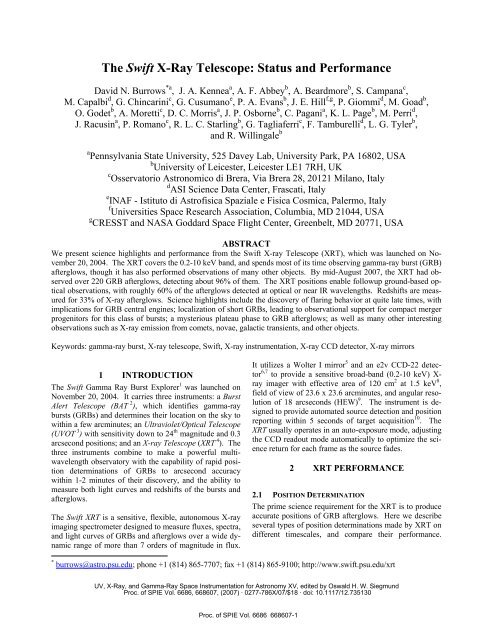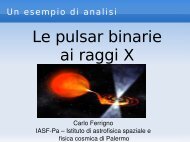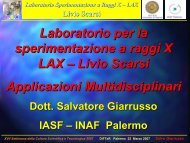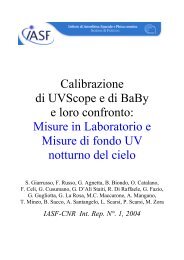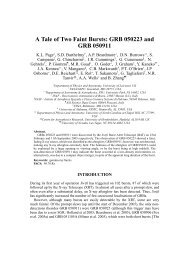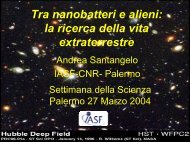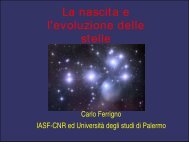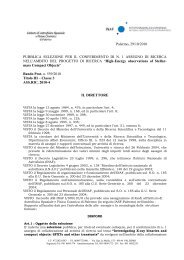The Swift X-Ray Telescope: Status and Performance - IASF Palermo
The Swift X-Ray Telescope: Status and Performance - IASF Palermo
The Swift X-Ray Telescope: Status and Performance - IASF Palermo
Create successful ePaper yourself
Turn your PDF publications into a flip-book with our unique Google optimized e-Paper software.
<strong>The</strong> <strong>Swift</strong> X-<strong>Ray</strong> <strong>Telescope</strong>: <strong>Status</strong> <strong>and</strong> <strong>Performance</strong><br />
David N. Burrows *a , J. A. Kennea a , A. F. Abbey b , A. Beardmore b , S. Campana c ,<br />
M. Capalbi d , G. Chincarini c , G. Cusumano e , P. A. Evans b , J. E. Hill f,g , P. Giommi d , M. Goad b ,<br />
O. Godet b , A. Moretti c , D. C. Morris a , J. P. Osborne b , C. Pagani a , K. L. Page b , M. Perri d ,<br />
J. Racusin a , P. Romano c , R. L. C. Starling b , G. Tagliaferri c , F. Tamburelli d , L. G. Tyler b ,<br />
<strong>and</strong> R. Willingale b<br />
a Pennsylvania State University, 525 Davey Lab, University Park, PA 16802, USA<br />
b University of Leicester, Leicester LE1 7RH, UK<br />
c Osservatorio Astronomico di Brera, Via Brera 28, 20121 Milano, Italy<br />
d ASI Science Data Center, Frascati, Italy<br />
e INAF - Istituto di Astrofisica Spaziale e Fisica Cosmica, <strong>Palermo</strong>, Italy<br />
f Universities Space Research Association, Columbia, MD 21044, USA<br />
g CRESST <strong>and</strong> NASA Goddard Space Flight Center, Greenbelt, MD 20771, USA<br />
ABSTRACT<br />
We present science highlights <strong>and</strong> performance from the <strong>Swift</strong> X-ray <strong>Telescope</strong> (XRT), which was launched on November<br />
20, 2004. <strong>The</strong> XRT covers the 0.2-10 keV b<strong>and</strong>, <strong>and</strong> spends most of its time observing gamma-ray burst (GRB)<br />
afterglows, though it has also performed observations of many other objects. By mid-August 2007, the XRT had observed<br />
over 220 GRB afterglows, detecting about 96% of them. <strong>The</strong> XRT positions enable followup ground-based optical<br />
observations, with roughly 60% of the afterglows detected at optical or near IR wavelengths. Redshifts are measured<br />
for 33% of X-ray afterglows. Science highlights include the discovery of flaring behavior at quite late times, with<br />
implications for GRB central engines; localization of short GRBs, leading to observational support for compact merger<br />
progenitors for this class of bursts; a mysterious plateau phase to GRB afterglows; as well as many other interesting<br />
observations such as X-ray emission from comets, novae, galactic transients, <strong>and</strong> other objects.<br />
Keywords: gamma-ray burst, X-ray telescope, <strong>Swift</strong>, X-ray instrumentation, X-ray CCD detector, X-ray mirrors<br />
1 INTRODUCTION<br />
<strong>The</strong> <strong>Swift</strong> Gamma <strong>Ray</strong> Burst Explorer 1 was launched on<br />
November 20, 2004. It carries three instruments: a Burst<br />
Alert <strong>Telescope</strong> (BAT 12 ), which identifies gamma-ray<br />
bursts (GRBs) <strong>and</strong> determines their location on the sky to<br />
within a few arcminutes; an Ultraviolet/Optical <strong>Telescope</strong><br />
(UVOT 3 ) with sensitivity down to 24 th magnitude <strong>and</strong> 0.3<br />
arcsecond positions; <strong>and</strong> an X-ray <strong>Telescope</strong> (XRT 4 ). <strong>The</strong><br />
three instruments combine to make a powerful multiwavelength<br />
observatory with the capability of rapid position<br />
determinations of GRBs to arcsecond accuracy<br />
within 1-2 minutes of their discovery, <strong>and</strong> the ability to<br />
measure both light curves <strong>and</strong> redshifts of the bursts <strong>and</strong><br />
afterglows.<br />
<strong>The</strong> <strong>Swift</strong> XRT is a sensitive, flexible, autonomous X-ray<br />
imaging spectrometer designed to measure fluxes, spectra,<br />
<strong>and</strong> light curves of GRBs <strong>and</strong> afterglows over a wide dynamic<br />
range of more than 7 orders of magnitude in flux.<br />
It utilizes a Wolter I mirror 5 <strong>and</strong> an e2v CCD-22 detector<br />
6,7 to provide a sensitive broad-b<strong>and</strong> (0.2-10 keV) X-<br />
ray imager with effective area of 120 cm 2 at 1.5 keV 8 ,<br />
field of view of 23.6 x 23.6 arcminutes, <strong>and</strong> angular resolution<br />
of 18 arcseconds (HEW) 9 . <strong>The</strong> instrument is designed<br />
to provide automated source detection <strong>and</strong> position<br />
reporting within 5 seconds of target acquisition 10 . <strong>The</strong><br />
XRT usually operates in an auto-exposure mode, adjusting<br />
the CCD readout mode automatically to optimize the science<br />
return for each frame as the source fades.<br />
2 XRT PERFORMANCE<br />
2.1 POSITION DETERMINATION<br />
<strong>The</strong> prime science requirement for the XRT is to produce<br />
accurate positions of GRB afterglows. Here we describe<br />
several types of position determinations made by XRT on<br />
different timescales, <strong>and</strong> compare their performance.<br />
* burrows@astro.psu.edu; phone +1 (814) 865-7707; fax +1 (814) 865-9100; http://www.swift.psu.edu/xrt<br />
UV, X-<strong>Ray</strong>, <strong>and</strong> Gamma-<strong>Ray</strong> Space Instrumentation for Astronomy XV, edited by Oswald H. W. Siegmund<br />
Proc. of SPIE Vol. 6686, 668607, (2007) · 0277-786X/07/$18 · doi: 10.1117/12.735130<br />
Proc. of SPIE Vol. 6686 668607-1
<strong>The</strong>se are discussed in the order in which they become<br />
available after a GRB is detected by <strong>Swift</strong>.<br />
2.1.1 On-board Centroids<br />
GRB afterglows are often quite bright at early times, far<br />
brighter than typical background sources (see Fig. 1), <strong>and</strong><br />
the rapid slewing capability of the <strong>Swift</strong> observatory<br />
means that XRT count rates are often between 10 <strong>and</strong> 100<br />
counts per second when the instrument is first pointed at a<br />
new burst (typically within 2 minutes after the burst occurs).<br />
<strong>The</strong> XRT takes advantage of this by taking a 0.1 s<br />
image <strong>and</strong> a 2.5 s image immediately after the slew to the<br />
GRB ends, <strong>and</strong> attempting to find a bright X-ray source in<br />
either image. If a source is found, its centroid position is<br />
reported to the ground via the TDRSS satellite network<br />
for distribution to the astronomical community 11 . While<br />
rapid, the accuracy of these centroids is limited by the low<br />
photon statistics typically available <strong>and</strong> by the fact that<br />
the satellite is still drifting slowly, as well as by detector<br />
artifacts (such as hot pixels <strong>and</strong> columns) <strong>and</strong> cosmic ray<br />
events 43 . Nevertheless, typical accuracy is of order 5-6<br />
arcseconds at very early times. Figure 2 shows the offsets<br />
in sky position between XRT on-board centroid positions<br />
<strong>and</strong> optical positions for all GRB afterglows that have<br />
both XRT centroid <strong>and</strong> optical positions. Figure 3 shows<br />
these offsets as a function of GRB number (roughly proportional<br />
to time).<br />
XRT Position Errors<br />
Offset (arcsec)<br />
25.0<br />
20.0<br />
15.0<br />
10.0<br />
5.0<br />
0.0<br />
1 6 11 16 21 26 31 36 41 46 51 56 61 66 71 76 81 86<br />
GRB #<br />
Figure 1: Typical XRT afterglow. Each dot represents an<br />
X-ray photon. <strong>The</strong> circle is the BAT error circle for the<br />
burst. XRT afterglows are typically the brightest object<br />
inside the BAT error circle.<br />
delta Dec (arcseconds)<br />
XRT GRB Position Errors<br />
7<br />
6<br />
5<br />
4<br />
3<br />
2<br />
1<br />
0<br />
-7 -6 -5 -4 -3 -2 -1<br />
-1<br />
0 1 2 3 4 5 6 7<br />
-2<br />
-3<br />
-4<br />
-5<br />
-6<br />
-7<br />
delta RA (arcseconds)<br />
2005<br />
2006<br />
2007<br />
Figure 2: Position errors between on-board centroids <strong>and</strong> optical<br />
positions for GRB afterglows. Circles are 3”, 5”, <strong>and</strong> 7”.<br />
Figure 3: Errors between on-board centroids <strong>and</strong> optical positions<br />
of GRB afterglows, as a function of GRB number. <strong>The</strong><br />
first few GRBs, with high errors, were before calibration of the<br />
instrument boresight. After that point, typical errors are less<br />
than 5 arcseconds.<br />
Excluding the first few GRBs, which occurred before<br />
completion of boresight calibration, the mean offsets<br />
between X-ray <strong>and</strong> optical positions is -1.1 arcseconds in<br />
Right Ascension (RA) <strong>and</strong> -0.8 arcseconds in Declination.<br />
<strong>The</strong> mean (median) offset between X-ray <strong>and</strong> optical<br />
positions using this method is 4.8 (4.4) arcseconds.<br />
2.1.2 Prompt Ground-based Positions<br />
Since May 1, 2006, the XRT has been using a new onboard<br />
software feature that transmits single-pixel X-ray<br />
events to the ground via TDRSS during the first orbit’s<br />
worth of observations of a new GRB. <strong>The</strong>se data, referred<br />
to as SPER data, allow a relatively rapid calculation<br />
of the GRB afterglow position using ground-based<br />
software that is more accurate than the on-board centroiding<br />
software. <strong>The</strong>se improved SPER positions are generally<br />
available within 5-10 minutes after the burst, except<br />
in cases where the count rate is so high that no Photon-<br />
Counting mode data 12 are acquired during the first orbit.<br />
Beginning in August 2007, the XRT team distributes<br />
Proc. of SPIE Vol. 6686 668607-2
XRT Position Notices to the astronomical community<br />
when the first SPER position becomes available for each<br />
burst. (We do not continue to distribute notices each time<br />
the position is improved with subsequent SPER data.)<br />
the spacecraft has stopped drifting when these data are<br />
produced, <strong>and</strong> partly because of an improved PSF fitting<br />
routine discussed in section §2.1.4.<br />
2.1.3 Ground-based positions<br />
On a typical time-scale of 2-3 hours after the burst a<br />
ground-processed position can be determined using the<br />
delta Dec (arcseconds)<br />
<strong>The</strong> accuracy of the SPER messages is illustrated in Figure<br />
4, which shows offsets between XRT <strong>and</strong> optical positions<br />
for GRBs with both SPER <strong>and</strong> optical positions.<br />
<strong>The</strong> mean offsets are 0.2 arcseconds in RA <strong>and</strong> 0.1<br />
arcseconds in Declination. <strong>The</strong> X-ray/optical offsets are<br />
shown as a function of GRB number in Figure 5. <strong>The</strong><br />
mean (median) offset is 3.2 (2.6) arcseconds, significantly<br />
better than the on-board positions. <strong>The</strong> improvement is<br />
partly the result of better photon statistics, partly because<br />
Offset (arcsec)<br />
8.0<br />
7.0<br />
6.0<br />
5.0<br />
4.0<br />
3.0<br />
2.0<br />
1.0<br />
0.0<br />
XRT GRB Position Errors<br />
XRT Position Errors<br />
1 3 5 7 9 11 13 15 17 19 21 23 25 27 29<br />
GRB #<br />
Figure 5: X-ray <strong>and</strong> optical offsets for SPER positions.<br />
7<br />
6<br />
5<br />
4<br />
3<br />
2<br />
1<br />
0<br />
-7 -6 -5 -4 -3 -2 -1 0<br />
-1<br />
1 2 3 4 5 6 7<br />
-2<br />
-3<br />
-4<br />
-5<br />
-6<br />
-7<br />
delta RA (arcseconds)<br />
2006<br />
2007<br />
Figure 4: Position errors for SPER positions for GRBs with both<br />
SPER X-ray positions <strong>and</strong> optical positions.<br />
delta Dec (arcseconds)<br />
XRT GRB Position Errors<br />
7<br />
6<br />
5<br />
4<br />
3<br />
2<br />
1<br />
0<br />
-7 -6 -5 -4 -3 -2 -1 -1 0 1 2 3 4 5 6 7<br />
-2<br />
-3<br />
-4<br />
-5<br />
-6<br />
-7<br />
delta RA (arcseconds)<br />
2005<br />
2006<br />
2007<br />
Figure 6: Position errors for refined ground-calculated positions<br />
for GRB with optical positions.<br />
full data set downloaded to the Malindi ground station.<br />
<strong>The</strong> techniques used in this position determination have<br />
been described previously 13 . <strong>The</strong> resulting position accuracy<br />
is shown in Figure 6. Most of the X-ray positions<br />
are within 5 arcseconds of the optical positions. <strong>The</strong><br />
mean offsets are -0.07 arcseconds in RA <strong>and</strong> -0.2<br />
arcseconds in Declination. <strong>The</strong> offsets are shown in Figure<br />
7; the mean (median) offset is 2.6 (2.5) arcseconds.<br />
Offset (arcsec)<br />
8.0<br />
6.0<br />
4.0<br />
2.0<br />
XRT Position Errors<br />
0.0<br />
1 8 15 22 29 36 43 50 57 64 71 78 85 92 99 106 113 120 127<br />
GRB #<br />
Figure 7: X-ray <strong>and</strong> optical offsets for ground-calculated<br />
refined GRB positions. <strong>The</strong> mean position error is 2.6<br />
arcseconds.<br />
Proc. of SPIE Vol. 6686 668607-3
delta Dec (arcseconds)<br />
XRT GRB Position Errors<br />
7<br />
6<br />
5<br />
4<br />
3<br />
2<br />
1<br />
0<br />
-7 -6 -5 -4 -3 -2 -1 0<br />
-1<br />
1 2 3 4 5 6 7<br />
-2<br />
-3<br />
-4<br />
-5<br />
-6<br />
-7<br />
delta RA (arcseconds)<br />
2005<br />
2006<br />
2007<br />
Figure 8: Position errors for XRT astrometrically-corrected<br />
(UVOT-enhanced) positions 14 for bursts with optical counterparts.<br />
Note that errors in the optical positions are no longer<br />
negligible at these offset values, <strong>and</strong> may contribute significantly.<br />
Offset (arcsec)<br />
8.0<br />
6.0<br />
4.0<br />
2.0<br />
2.1.4 Astrometric positions<br />
<strong>The</strong> uncertainties in the techniques listed above are dominated<br />
by two components: photon statistics, <strong>and</strong> the uncertainty<br />
in the star tracker solutions, which imposes a<br />
lower limit of about 3 arcseconds on the XRT position<br />
accuracy. We have recently developed a technique 14 that<br />
eliminates the latter (star tracker) component by using the<br />
UVOT instrument as a “super star tracker”, taking advantage<br />
of the precise registration achievable between UVOT<br />
images <strong>and</strong> astrometric star catalogs, <strong>and</strong> of the highly<br />
stable <strong>Swift</strong> Optical Bench, which maintains the relative<br />
alignment between the XRT <strong>and</strong> UVOT boresights to<br />
better than an arcsecond in flight. We achieve additional<br />
improvements by using a fitting routine to determine XRT<br />
source positions in detector coordinates that accounts for<br />
the instrument PSF <strong>and</strong> that correctly <strong>and</strong> accurately treats<br />
the effects of bad pixels <strong>and</strong> columns. <strong>The</strong> resulting position<br />
errors are shown in Figure 8. <strong>The</strong> mean offsets are<br />
0.01 arcseconds in RA <strong>and</strong> -0.08 arcseconds in Declination.<br />
<strong>The</strong> position offsets are shown in Figure 9; the mean<br />
(median) offset is 1.9 (1.4) arcseconds for these “UVOTenhanced”<br />
positions. We note that at these small offsets,<br />
errors in the optical positions become significant. We<br />
have used optical positions given in GCN Circulars, most<br />
of which do not identify the astrometric system used to<br />
derive them, <strong>and</strong> many of which do not specify their astrometric<br />
uncertainties. In these figures we have simply<br />
plotted the difference between the best X-ray <strong>and</strong> optical<br />
positions. Testing of this technique using bursts with<br />
UVOT afterglows shows that 90% of the XRT positions<br />
are within 2 arcseconds of the UVOT position 14 .<br />
<strong>The</strong> procedure used to produce these “UVOT-enhanced”<br />
positions has been described in detail elsewhere 14 . <strong>The</strong>se<br />
positions are available for about 60% of <strong>Swift</strong> bursts<br />
(availability requires that the XRT obtain PC mode data<br />
simultaneously with UVOT V b<strong>and</strong> images). For new<br />
bursts, these improved positions are generally available<br />
within a few hours after the burst (i.e., on a similar timescale<br />
to the st<strong>and</strong>ard refined ground-processed positions),<br />
<strong>and</strong> are distributed automatically to the community when<br />
they become available. <strong>The</strong> position accuracy achieved<br />
with this technique is comparable to that achieved through<br />
astrometric positions based on matching serendipitous<br />
sources in deep XRT exposures to astrometric catalogs,<br />
but on time scales of hours rather than days or weeks.<br />
2.2 SPECTROSCOPY<br />
XRT Position Errors<br />
0.0<br />
1 5 9 13172125293337414549535761656973778185899397<br />
GRB #<br />
Figure 9: Position offsets between UVOT-enhanced X-ray<br />
positions <strong>and</strong> optical positions vs GRB number. We note<br />
that the GRB numbering is different for each of these<br />
plots, <strong>and</strong> simply represents the ordinal number of the<br />
GRB within the particular subsample being plotted.<br />
Prior to launch, we expected that some of the most exciting<br />
results from the <strong>Swift</strong> XRT would be related to measurements<br />
of emission lines in X-ray spectra. Previous<br />
work had found evidence at later times for spectral lines<br />
from Fe <strong>and</strong> other heavy elements 15,16 , <strong>and</strong> it was thought<br />
that with much earlier observations, when the afterglow<br />
was orders of magnitude brighter, the XRT might be able<br />
to confirm the previous rather marginal detections, <strong>and</strong><br />
even to use line detections to measure redshifts <strong>and</strong> place<br />
interesting constraints on the emission regions.<br />
Proc. of SPIE Vol. 6686 668607-4
2.3 TIMING<br />
<strong>The</strong> third important capability of the XRT is high resolution<br />
timing. Although many interesting results have come<br />
from XRT light curves of GRB afterglows, no interesting<br />
periodicities or other high frequency temporal phenomena<br />
have been identified to date.<br />
Figure 10: <strong>Swift</strong> XRT spectrum of the northern knot of the<br />
Cas A supernova remnant. <strong>The</strong> data are fit by an absorbed<br />
2 component non-equilibrium ionization spectral model<br />
that fits the data from the XMM MOS1 spectrum of this<br />
knot, scaled by a constant factor to account for uncertainties<br />
in the effective areas of the two instruments. <strong>The</strong><br />
spectrum is dominated by strong lines of Si, S, Ar, Ca, <strong>and</strong><br />
Fe.<br />
This has not turned out to be the case. <strong>The</strong> spectral resolution<br />
of the XRT is illustrated in Figure 10, which shows<br />
a spectrum of the northern knot of the Cas A supernova<br />
remnant taken in February 2005 during our on-orbit calibration.<br />
<strong>The</strong> spectrum is dominated by strong lines of<br />
hydrogen-like <strong>and</strong> helium-like Si, S, Ar, Ca, <strong>and</strong> Fe. By<br />
contrast, we show a typical GRB spectrum in Figure 11.<br />
This spectrum is fit by a simple absorbed power law, with<br />
no hint of any spectral lines. We occasionally find other<br />
spectral components: flares often exhibit a more complex<br />
spectrum described by a B<strong>and</strong> function or cutoff power<br />
law, <strong>and</strong> a few bursts have soft excesses that can be fit<br />
with a blackbody component, but we have seen no spectral<br />
lines in any GRB afterglow 17 .<br />
i.:)•<br />
gill.<br />
+<br />
Figure 11: XRT spectrum of GRB 051008. <strong>The</strong> best fit is<br />
to a simple absorbed power law.<br />
3 SCIENCE HIGHLIGHTS<br />
Scientific implications of the <strong>Swift</strong> XRT data have been<br />
published elsewhere in journals <strong>and</strong> conference proceedings.<br />
Here we will simply highlight a few of the key results.<br />
3.1 XRT AFTERGLOW STATISTICS<br />
As of mid-August 2007, the XRT has observed 231 GRBs<br />
detected by the <strong>Swift</strong> BAT instrument (as well as several<br />
dozen detected by HETE-II, INTEGRAL, <strong>and</strong> AGILE).<br />
<strong>The</strong> XRT has detected 96% of the BAT-discovered bursts<br />
(221 detected X-ray counterparts). This represents more<br />
than 4 times the total sample of X-ray afterglows of GRBs<br />
observed before the launch of <strong>Swift</strong>. <strong>The</strong> sample of X-ray<br />
afterglows with prompt observations includes 181 bursts<br />
(most of the remainder had observations delayed by Earth<br />
occultations). <strong>The</strong> mean (median) time on target for<br />
prompt XRT observations of BAT-detected bursts was<br />
103 (95) seconds after the burst trigger.<br />
GRBs come in (at least) two types, generally called long<br />
<strong>and</strong> short GRBs 18 . Long GRBs are thought to originate in<br />
the collapse of massive stars. <strong>The</strong> XRT has detected 98%<br />
of the 202 BAT-discovered long GRBs it has observed to<br />
date. <strong>The</strong> XRT detection rate of short GRBs is considerably<br />
lower, with 19 out of 24 short GRBs discovered by<br />
the BAT being detected by the XRT. <strong>The</strong> short GRBs<br />
tend to have much weaker afterglows, <strong>and</strong> many of them<br />
fade quickly, with only a few dozen photons detected.<br />
Because of the high detection rate for X-ray afterglows<br />
<strong>and</strong> the small error circles provided by the XRT, X-ray<br />
detections often facilitate the discovery of optical afterglows.<br />
<strong>The</strong> redshift distribution of long <strong>Swift</strong> GRBs is<br />
shown in Figure 12. Reliable redshifts have been determined<br />
for about 1/3 of the bursts with XRT detections.<br />
<strong>The</strong> mean redshift through mid-August 2007 is 2.4, which<br />
is about twice the mean redshift for pre-<strong>Swift</strong> GRBs. Five<br />
<strong>Swift</strong> GRBs have redshifts greater than 5.0: GRB 050814<br />
(5.3), GRB 050904 (6.3), GRB 060116 (6.6), GRB<br />
060522 (5.1), <strong>and</strong> GRB 060927 (5.6).<br />
Proc. of SPIE Vol. 6686 668607-5
Frequency<br />
16<br />
14<br />
12<br />
10<br />
8<br />
6<br />
4<br />
2<br />
0<br />
0<br />
1<br />
2<br />
3.2 X-RAY FLARES<br />
3<br />
<strong>The</strong> typical GRB afterglow is expected to fade as a power<br />
law in time, <strong>and</strong> many GRB X-ray afterglows do decay as<br />
a series of power laws of differing decay index, but the<br />
XRT data show that many afterglows exhibit much more<br />
complex behavior. X-ray flares have been found in a<br />
large fraction of <strong>Swift</strong> GRB afterglows 19-25 . <strong>The</strong> flares are<br />
characterized by large, rapid flux variations. <strong>The</strong> largest<br />
flare seen to date had fluence equal to that of the prompt<br />
-ray emission 21 . <strong>The</strong> probability of flare occurrence decreases<br />
linearly with time since the burst. <strong>The</strong> most likely<br />
explanation for the flares is that the “central engine” of<br />
the GRB continues to be intermittently active long after<br />
4<br />
Redshift<br />
Figure 12: Redshift distribution of long <strong>Swift</strong> GRBs through<br />
mid-August 2007. <strong>The</strong> mean (median) redshift is 2.39 (2.35).<br />
<strong>The</strong> highest redshift is a photometric redshift of 6.6 for GRB<br />
060116.<br />
5<br />
6<br />
7<br />
the burst of -rays ends. Indeed, the central engine activity<br />
must continue for times up to hours after the burst (Fig<br />
13).<br />
3.3 RAPID DECAY PHASE<br />
An unexpected discovery is that many X-ray light curves<br />
begin with an extremely steep decay, of order t -3 or<br />
steeper, during which the flux drops by several orders of<br />
magnitude for some tens of minutes (Figure 14) 27-30 . This<br />
phase has been explained as the result of the end of the<br />
prompt emission, <strong>and</strong> although explained theoretically<br />
before the launch of <strong>Swift</strong> 31 , had not previously been seen.<br />
3.4 THE PLATEAU PHASE<br />
Another unexpected feature of the X-ray light curves is a<br />
plateau phase, in which the decaying light curve flattens<br />
to a very low decay index (nearly constant in time) for a<br />
period of several hours. An example is the light curve of<br />
GRB 060729 32 (Figure 14). This plateau has been interpreted<br />
as evidence for quasi-continuous injection of energy<br />
into the external shock with the ambient medium 28-29 ,<br />
but the unusual plateau phase of GRB 070110 33 , which<br />
terminates very abruptly, cannot be explained by this<br />
mechanism, suggesting that at least some plateaus are<br />
related to quasi-continuous late-time central engine activity.<br />
IO<br />
GRB 060729<br />
I () —<br />
Plateau phase<br />
—. — ,<br />
~ 40 ks<br />
flstt%1J11L¼<br />
½<br />
IO 1o4 1o5 io<br />
seconds since BAT trigger<br />
Figure 14: <strong>The</strong> extraordinarily long afterglow of GRB<br />
060729, the longest X-ray afterglow observed to date by the<br />
<strong>Swift</strong> XRT 32 .<br />
Figure 13: <strong>The</strong> flaring X-ray afterglow of GRB 050730 26 .<br />
Flaring continues out to at least 30,000 s after the burst (in<br />
the observer frame).<br />
Proc. of SPIE Vol. 6686 668607-6
3.5 SHORT GRB LOCALIZATIONS<br />
Short GRBs had eluded localization until May 9, 2005,<br />
when the <strong>Swift</strong> BAT detected GRB 050509B <strong>and</strong> the XRT<br />
localized it to within 10 arcseconds of a giant elliptical<br />
galaxy in a cluster 34 . This was remarkable in several regards.<br />
No long GRB had ever been localized to an elliptical<br />
galaxy. In fact, no long GRB had ever been localized<br />
to any galaxy in a cluster. Long GRBs are typically associated<br />
with small irregular galaxies <strong>and</strong> are localized to<br />
regions of active star formation, consistent with their deduced<br />
origin in the demise of massive stars, which are<br />
born in star forming regions <strong>and</strong> which evolve rapidly <strong>and</strong><br />
die young. Elliptical galaxies, on the other h<strong>and</strong>, contain<br />
only very old stars, <strong>and</strong> have no current star formation.<br />
This clearly points to a different origin for short GRBs<br />
than for long ones, <strong>and</strong> supports theories that short GRBs<br />
may originate in the merger of two neutron stars or a neutron<br />
star <strong>and</strong> a black hole, rather than in the collapse of a<br />
massive star 35,36 . Subsequent short GRB localizations<br />
generally support this picture 37 , although the situation is<br />
complicated by a lack of clear host galaxies for many<br />
short bursts, <strong>and</strong> by the lack of any short bursts for which<br />
the distance has been measured directly by red-shifted<br />
absorption lines in the light of the optical afterglow (instead,<br />
short GRB distances have been measured by spectral<br />
lines from the host galaxy, which is often ambiguous).<br />
3.6 OTHER SCIENCE<br />
When <strong>Swift</strong> is not observing GRB afterglows, it performs<br />
a wide variety of other science observations, many of<br />
which rely on the XRT for their primary results. As part<br />
of its active Target of Opportunity (ToO) program, the<br />
XRT has provided precise positions of both transient <strong>and</strong><br />
steady sources discovered by the <strong>Swift</strong> BAT instrument,<br />
by the INTEGRAL satellite, <strong>and</strong> by the RXTE satellite.<br />
We have observed objects ranging from comets 38 to novae<br />
39 to supernovae 40 <strong>and</strong> active galactic nuclei 41 . <strong>The</strong><br />
success of these observations clearly demonstrates the<br />
utility <strong>and</strong> importance of an X-ray telescope with rapid<br />
response capability (the XRT has executed a ToO observation<br />
in as little as 40 minutes after the event was discovered,<br />
<strong>and</strong> can often respond within an hour or two for<br />
high priority ToOs).<br />
4 CONCLUSIONS<br />
<strong>The</strong> <strong>Swift</strong> XRT has been remarkably successful in its first<br />
two years of operation. <strong>The</strong> instrument is healthy <strong>and</strong> is<br />
working well, in spite of the loss of the active cooling<br />
system shortly after launch, <strong>and</strong> the effects of a micrometeoroid<br />
impact on the detector in May 2005 42 . <strong>Swift</strong> has<br />
no expendables <strong>and</strong> we expect it to continue operating for<br />
many years, exp<strong>and</strong>ing our knowledge of GRB physics<br />
<strong>and</strong> transient phenomena in our Galaxy <strong>and</strong> in the Universe.<br />
5 ACKNOWLEDGEMENTS<br />
This work is supported at Penn State by NASA contract<br />
NAS5-00136; at the University of Leicester by the Particle<br />
Physics <strong>and</strong> Astronomy Research Council; <strong>and</strong> at<br />
OAB, <strong>Palermo</strong>, <strong>and</strong> the ASDC by funding from ASI. We<br />
gratefully acknowledge the contributions of dozens of<br />
members of the XRT team at PSU, UL, OAB, GSFC, <strong>and</strong><br />
our subcontractors, who helped make this instrument possible.<br />
In particular, we would like to acknowledge the contributions<br />
of our friend <strong>and</strong> colleague, Francesca Tamburelli,<br />
who passed away earlier this year. Francesca was part of<br />
the Beppo-SAX Science Data Center <strong>and</strong> the ASI Science<br />
Data Center from their inception. She was the main architect<br />
behind the <strong>Swift</strong> <strong>and</strong> AGILE data systems. We<br />
have lost a bright mind <strong>and</strong> a dear friend.<br />
6 REFERENCES<br />
1. N. Gehrels et al., “<strong>The</strong> <strong>Swift</strong> Gamma-<strong>Ray</strong> Burst Mission”,<br />
Astrophys.J., 611, 1005-1020, 2004.<br />
2. S. Barthelmy et al., “<strong>The</strong> Burst Alert <strong>Telescope</strong><br />
(BAT) on the SWIFT Midex Mission”, Space Sci.<br />
Rev., 120, 143-164, 2005.<br />
3. P. W. A. Roming et al., “<strong>The</strong> <strong>Swift</strong> Ultra-<br />
Violet/Optical <strong>Telescope</strong>”, Space Sci. Rev., 120, 94-<br />
142, 2005.<br />
4. D. N. Burrows et al., “<strong>The</strong> <strong>Swift</strong> X-ray <strong>Telescope</strong>”,<br />
Space Sci. Rev., 120, 165-195, 2005.<br />
5. O. Citterio et al., “Characteristics of the flight model<br />
optics for the JET-X telescope onboard the SPEC-<br />
TRUM X- satellite”, Proc. SPIE, 2805, 56-65, 1996.<br />
6. A. D. Holl<strong>and</strong>, M. J. L. Turner, A. F. Abbey, P. J.<br />
Pool, “MOS CCDs for the EPIC on XMM”, Proc.<br />
SPIE, 2808, 414-420, 1996.<br />
7. A .D. T. Short, A. Keay, M. J. L. Turner, “<strong>Performance</strong><br />
of the XMM EPIC MOS CCD Detectors”, Proc.<br />
SPIE, 3445, 13-27, 1998.<br />
Proc. of SPIE Vol. 6686 668607-7
8. P. Romano et al., “In-flight calibration of the <strong>Swift</strong><br />
XRT effective area”, Proc. SPIE, 5898, 589819-1,<br />
2005.<br />
9. A. Moretti et al., “In-flight calibration of the <strong>Swift</strong><br />
XRT Point Spread Function”, Proc. SPIE, 5898,<br />
589818-1, 2005.<br />
10. J. E. Hill et al., “<strong>The</strong> Unique Observing Capabilities<br />
of the <strong>Swift</strong> X-ray <strong>Telescope</strong>”, Proc. SPIE, 5898,<br />
589815-1, 2005.<br />
11. J. E. Hill et al., “An Algorithm for Locating PSF-<br />
Like Events <strong>and</strong> Computing the Centroid in X-ray<br />
Images”, Proc. SPIE, 4851, 1347-1355, 2003.<br />
12. J. E. Hill et al., “Readout Modes <strong>and</strong> Automated Operation<br />
of the <strong>Swift</strong> X-ray <strong>Telescope</strong>”, Proc. SPIE,<br />
5165, 217-231, 2004.<br />
13. A. Moretti et al., “A refined position catalog of the<br />
<strong>Swift</strong> XRT afterglows”, Astron. & Astrophys., 448,<br />
L9-L12, 2005.<br />
14. M. Goad et al., “Accurate early positions for <strong>Swift</strong><br />
GRBs: enhancing X-ray positions with UVOT astrometry”,<br />
Astron.&Astrophys, submitted, 2007.<br />
15. L. Piro et al., “Observation of X-ray Lines from a<br />
Gamma-<strong>Ray</strong> Burst (GRB 991216): Evidence of Moving<br />
Ejecta from the Progenitor”, Science, 290, 955-<br />
958, 2000.<br />
16. J. Reeves et al., “<strong>The</strong> Signature of Supernova Ejecta<br />
in the X-ray Afterglow of the -ray Burst 011211”,<br />
Nature, 416, 512-515, 2002.<br />
17. C. P. Hurkett et al., “Line Searches in <strong>Swift</strong> X-ray<br />
Spectra: Methods, Detection Limits <strong>and</strong> Results”, Astrophys.<br />
J., submitted.<br />
18. C. Kouveliotou et al., “Identification of two classes<br />
of gamma-ray bursts”, Astrophys. J., 413, L101-<br />
L104, 1993.<br />
19. D. N. Burrows et al., “Bright X-ray Flares in<br />
Gamma-<strong>Ray</strong> Burst Afterglows”, Science, 309, 1833-<br />
1835, 2005.<br />
20. P. Romano et al., “X-ray Flare in XRF 050406: Evidence<br />
for Prolonged Engine Activity”, Astron. & Astrophys.,<br />
450, 59-68, 2006.<br />
21. A. D. Falcone et al., “<strong>The</strong> Giant X-ray Flare of GRB<br />
050502B: Evidence for Late-Time Internal Engine<br />
Activity”, Astrophys. J., 641, 1010-1017, 2006.<br />
22. E. W. Liang et al., “Testing the Curvature Effect <strong>and</strong><br />
Internal Origin of Gamma-<strong>Ray</strong> Burst Prompt Emissions<br />
<strong>and</strong> X-<strong>Ray</strong> Flares with <strong>Swift</strong> Data”, Astrophys.<br />
J., 646, 351-357, 2006,<br />
23. D. Guetta et al., “Analysis of X-ray Flares in GRBs”,<br />
Il Nuovo Cimento, in press , 2007.<br />
24. D. N. Burrows et al., “X-ray Flares in Early GRB<br />
Afterglows”, Phil. Trans. Royal Soc. A, 365, 1213-<br />
1226, 2007.<br />
25. G. Chincarini et al., “<strong>The</strong> First Survey of X-ray<br />
Flares from Gamma <strong>Ray</strong> Bursts Observed by <strong>Swift</strong>:<br />
Temporal Properties <strong>and</strong> Morphology”, Astrophys. J.,<br />
in press (astro-ph/0702371).<br />
26. M. Perri et al., “<strong>The</strong> exceptionally extended flaring<br />
activity in the X-ray afterglow of GRB 050730 observed<br />
with <strong>Swift</strong> <strong>and</strong> XMM-Newton”, Astron. & Astrophys.,<br />
471, 83-92, 2007.<br />
27. G. Tagliaferri et al., “An unexpectedly rapid decline<br />
in the X-ray afterglow emission of long gamma-ray<br />
bursts”, Nature, 436, 985-989, 2005.<br />
28. J. A. Nousek et al., “Evidence for a Canonical GRB<br />
Afterglow Light Curve in the <strong>Swift</strong>/XRT Data”, Astrophys.<br />
J., 642, 389-400, 2005.<br />
29. B. Zhang et al., “Physical Processes Shaping GRB X-<br />
ray Afterglow Lightcurves: <strong>The</strong>oretical Implications<br />
from the <strong>Swift</strong> XRT Observations”, Astrophys. J.,<br />
642, 354-370, 2005.<br />
30. S. Barthelmy et al., “Discovery of an Afterglow Extension<br />
of the Prompt Phase of Two Gamma <strong>Ray</strong><br />
Bursts Observed by <strong>Swift</strong>”, Astrophys. J., 635, L133-<br />
L136, 2005.<br />
31. P. Kumar & A. Panaitescu, “Afterglow Emission<br />
from Naked Gamma-<strong>Ray</strong> Bursts”, Astrophys. J., 541,<br />
L51-L54, 2000.<br />
32. D. Grupe et al., “<strong>Swift</strong> <strong>and</strong> XMM-Newton Observations<br />
of the Extraordinary GRB 060729: more than<br />
125 Days of X-ray Afterglow”, Astrophys. J., in<br />
press, 2007.<br />
33. E. Troja et al., “<strong>Swift</strong> Observations of GRB 070110:<br />
an Extraordinary X-ray Afterglow Powered by the<br />
Central Engine”, Astrophys. J., in press, 2007.<br />
34. N. Gehrels et al., “A short -ray burst apparently associated<br />
with an elliptical galaxy at redshift z =<br />
0.225”, Nature, 437, 851-854, 2005.<br />
35. D. Eichler et al., “Nucleosynthesis, neutrino bursts,<br />
<strong>and</strong> -rays from coalescing neutron stars”, Nature,<br />
340, 126-128, 1989.<br />
36. S. Rosswog et al., “High Resolution Calculations of<br />
Merging Neutron Stars – III. Gamma-<strong>Ray</strong> Bursts”,<br />
Monthly Notices of the Royal Astron. Soc., 345,<br />
1077-1090, 2003.<br />
37. E. Nakar, “Short-hard Gamma-ray Bursts”, Physics<br />
Reports, 442, 166-236, 2007.<br />
38. R. Willingale et al., “<strong>Swift</strong> X-<strong>Ray</strong> <strong>Telescope</strong> Observations<br />
of the Deep Impact Collision”, Astrophys. J.,<br />
649, 541-552, 2006.<br />
39. J. P. Osborne et al., “<strong>The</strong> Super-Soft X-ray Phase of<br />
the Nova RS Oph 2006”, Astrophys. J., in prep, 2007.<br />
40. S. Immler, “X-<strong>Ray</strong> Observations of Type Ia Supernovae<br />
with <strong>Swift</strong>: Evidence of Circumstellar Interaction<br />
for SN 2005ke”, Astrophys. J., 648, L119-L122,<br />
2006.<br />
41. P. Giommi et al., “<strong>Swift</strong> <strong>and</strong> infra-red observations of<br />
the blazar 3C 454.3 during the giant X-ray flare of<br />
Proc. of SPIE Vol. 6686 668607-8
May 2005”, Astron. & Astrophys., 456, 911-961,<br />
2007.<br />
42. J. D. Carpenter et al., “Effects of micrometeoroid <strong>and</strong><br />
space debris impacts in grazing incidence telescopes”,<br />
Proc. SPIE, 6266, 62663K, 2006.<br />
43. J. E. Hill et al., “Rapid centroids <strong>and</strong> the refined position<br />
accuracy of the <strong>Swift</strong> gamma-ray burst catalogue”,<br />
Gamma-<strong>Ray</strong> Bursts in the <strong>Swift</strong> Era, ed.<br />
Stephen S. Holt, Neil Gehrels, <strong>and</strong> John A. Nousek.<br />
Berlin: Springer, ISBN 0-7354-0326-0, p. 297, 2006.<br />
Proc. of SPIE Vol. 6686 668607-9


